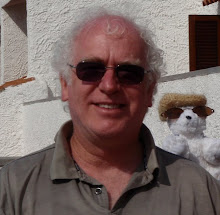










Fertilia
There are two main bus companies operating in Sardenia both of which offer highly reliable service, ARST and FDS. It seems that they both share terminals (fermata), ticket counters, and even certain inter-city routes, but they differ in the quality of their rolling stock. The ARST buses are all beautifully maintained in mint condition whereas the FDS buses are older and maintained as if they are being run on a much tighter budget. Nevertheless, they both accomplish their missions with fair comfort and in a timely manner. We caught the 06:30 ARST bus from Lanusei (Piazza Mercia...a 200m walk from the hostel) to Nuoro, but there is a scheduled switch in buses jjust outside Villanova...everybody gets off the bus (including the driver, and we waited on the other side of the road for the exchange bus. so, for some inexplicable reason, the two drivers exchange buses on this particular route and carry on their merry ways. In Nuuro, we said goodbye to Lucy Lou (Dr. Lucia Luz), a flamboyant Spanish professor with a PH.D in contemporary Egyptian literature taking a one year sabbatical from her teaching carreer to complete her semi-autobiographical novel about a woman studying for her PH.D in Egypt, the title translates in English to "In the Shadow of the Minaret". At 10:20 we were on the FDS bus to Sassari where we transferred again to an FDS bus to Alghero where we transferred a final time to the local bus (ALFA) to Fertilia. A 500m walk brought us to the Punta Negra seaside hotel where we will settle down for 5 nights. Had to make a return trip to the Alghero Tourist Information Office where I had left my GPS. We had met a fellow Canadian from Halifax who had sailed into town and was looking to purchase a tarpaulin, but was having trouble explaining exactly what he wanted. So, I laid my GPS on the counter to consult my dictionary and completely forgot to pick it after advising him that the word he needed was "impermeabile" or "incerata", both of which he carefully transcribed onto his map. Alghero is a lovely little town which was founded by the Doria family from Genoa in the early 12th century as one of two fortified cities along the northwest coast of Sardinia, the other is Castelsardo. Alghero was originally called "Alquerium" because of the abundant algae off its coast. The Genoese and Pisans wrangled control of Sardinia from the Arabs around 1000 A.D. after some very fierce battles, and ownership of both Sardinia and Corsica(!) was transferred to James II of Aragon by Pope Boniface VII by means of a papal bull in 1295. Sardinia remained under Spanish control until the Treaty of Utrecht in 1714 when it was ceded to the Austria who, in turn, ceded it to the House of Savoy in the treaty of London. A Sardinian revolt in 1799 lead eventually to the Savoys linked the kingdom of Sardinia with Piedmont both of which joined the kingdom of Italy in 1861. Despite their Italian nationality, the Sardinians remain a proud and distinct people and maintain their own language called Sardo, which we understand from a professor we met on a bus is much closer to the Spanish language than it is to the Italian.
Thde flag of Sardinia is a red cross on a white background with 4 moors with white bandanas on their heads. I asked a shop keeper why some depictions of the 4 moors show the bandanas over the eyes and others show the bandanas over the forehead. The shopkeepr said the former version (eyes covered) dates back to the Aragonese days and is the one favoured by most Sardinians...the the latter version (eyes open) is the new version which was adopted in 1999 when a social reform was adopted by the parliament of Sardinia and carries a reminder of their relationship with the Piedmontese in the early days of their new Italian identity.

No comments:
Post a Comment
You can post comments here or send e-mail to us a dcrowe2@gmail.com which we will be able to pick up fromj time to time whenever we are within a wifi area.